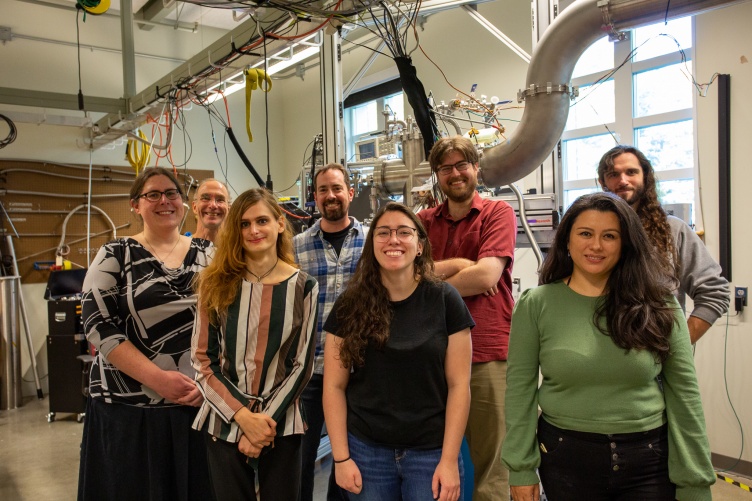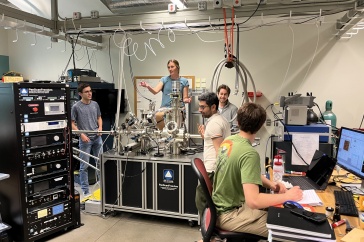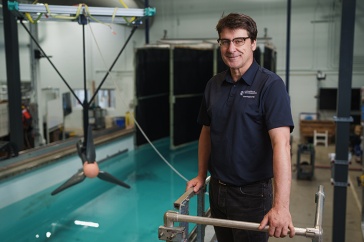
UNH's Nuclear and Particle Physics Group in front of its polarized target. From left: assistant professor Elena Long, professor Maurik Holtrop, postdoctoral researcher Allison Zec, professor Karl Slifer, graduate students Zoe Wolters and David Ruth, assistant professor Nathaly Santiesteban and graduate student Michael McClellan. Photo by Sydney Staples.

Though the science is aimed at matter not seen by the naked eye, the research of UNH’s Nuclear and Particle Physics Group (NPG) has caught the eyes of those in their field and beyond.
Nuclear physics is the study of the nucleus of the atom and is key to better understanding the universe. Real-world applications for the research include devices and technologies for medical diagnostics and therapy, energy production and exploration, safety and national security, and the analysis of materials and environmental contaminants.
The UNH group, founded four decades ago, has recently built a strong reputation for its expertise in polarized targets, which let researchers probe fundamental properties of the atom’s protons and deuterons much the way a microscope helps biologists see objects at the cellular level. That expertise has secured more than $17 million in funding from the Department of Energy (DOE) and spurred collaborations with the DOE National Laboratories, which conduct scientific research and development in areas related to energy and technology.
“The Department of Energy counts on UNH to help train the next generation of nuclear physicists that are critical for maintaining the U.S.’s excellence in the field.”
The NPG carries out experiments to better understand how spin, also called intrinsic angular momentum, is created in the proton from its smaller building blocks, quarks and gluons. “We know all the ingredients, and in principle how those ingredients interact, but after 40 years we still don’t have a simple cookbook recipe that shows how to take a handful of quarks and gluons and create a proton with this spin,” says Karl Slifer, professor of physics and lead principal investigator in the NPG.
NPG researchers are also testing the limits of the so-called “Standard Model,” the theory which describes everything known about the forces of nature. “Our research aims to understand how the natural world around us can be explained in terms of the basic constituents of matter and how this handful of simple particles interact to form the complex universe that we live in,” says Slifer.
He adds that although it may seem esoteric, over time this same basic question has repeatedly led to life-changing technological breakthroughs. Modern hospitals are outfitted with equipment that would have been cutting-edge nuclear physics research gear of decades past, including X-rays, positron emission tomography (PET) scans, electrocardiograms (EKGs), magnetic resonance imaging (MRIs) and more.
“Most cancer centers now have their own particle accelerators for treatment of tumors,” says Slifer, who studies spin and founded the solid polarized target effort in 2011. “All of these were enabled because of nuclear research, and it is my firm belief that the work we’re doing today will similarly benefit society in the future.”
Professor Maurik Holtrop, a member of NPG, leads an experiment to search for dark matter, a substance which is thought to account for 85% of the universe, but whose properties remain unknown. In recent years the NPG has grown to include assistant professors Elena Long and Nathaly Santiesteban.
“Together, we've developed a world-class facility at UNH, one of only a handful of such centers in the world,” says Slifer.
Annually, the support secured by NPG represents approximately 30% of all UNH funding from the DOE. Future group efforts will be directed to the Electron Ion Collider, the next-generation nuclear physics machine being constructed at Brookhaven National Lab.
UNH contributions to the field have extended far beyond the principal investigators to include numerous graduate and undergraduate students. A recent graduate, Shujie Li, was first author on an article in Nature discussing short range correlations in nuclei. A current graduate student, David Ruth, is first author on a publication discussing the spin structure of the proton. In addition, multiple undergraduate students have participated in programs with the DOE at National Lab sites.
A Mutually Beneficial Partnership

UNH is hosting a National Lab Day conference with the DOE National Labs on October 27 and 28, which includes a session led by the NPG. The goal of the event is to raise awareness of and engagement with the National Labs among UNH researchers, and to foster partnerships with researchers and industry around the region.
The partnership between the NPG and National Labs is one that is mutually beneficial in terms of personnel and technology transfers, including initiatives such as polarized targets, software development and detector construction.
“We benefit from close interaction with the scientific and technical staff at Jefferson Lab,” says Slifer. “That was extremely valuable in the initial stages when we were establishing our lab, as we had access to some of the world leading scientists to advise our efforts.”
The NPG’s short-range nucleon correlations program, which was labeled ‘high impact’ by DOE, was established when the late Patricia Solvignon joined the UNH physics faculty in a bridge position with Jefferson Lab. In terms of other personnel, the NPG has coordinated with 90 Jefferson Lab-affiliated faculty, postdoctoral researchers, graduate and undergraduate students working on Jefferson Lab-related projects.
Slifer notes that the DOE’s long-term goals and willingness to invest in projects that may take years to see progress is also beneficial. One example is the NPG’s effort to establish a tensor spin program at Jefferson Lab, which began in 2011 but only recently saw the technology developed catch up to the ambitious goals originally laid out.
“It is exciting to now be close to reaping the scientific rewards of running those experiments,” says Long. “Without DOE support that would have been impossible.”
From the other vantage point, Jefferson Lab has benefitted from working with UNH. “The DOE counts on UNH to help train the next generation of nuclear physicists that are critical for maintaining the U.S.’s excellence in the field,” says Holtrop.
-
Written By:
Brooks Payette | College of Engineering and Physical Sciences

















































